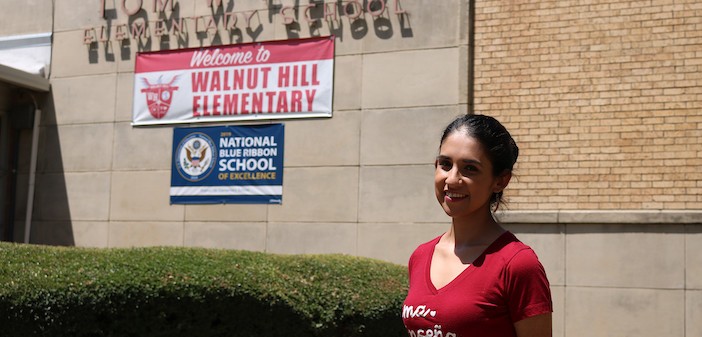When schools unexpectedly closed in March due to the Covid-19 threat, Walnut Hill Elementary School teacher Alejandra Ramos Gómez first found it tough to talk to students.
The kids were just bouncing back from the tornado that five months ago demolished their home campus, and she worried about the additional toll the epidemic would bring. After a few awkward virtual lessons, she fully embraced her professional and personal passion: social and emotional learning.
“We began talking to the students about how they were feeling and how their new reality was affecting them,” Gómez said. “I really wanted to allow them to express themselves so that they could develop an interest in showing up to class virtually.”
Gómez started a Facebook Page –“Aprendamos con Ms. Ramos” (Learning with Ms. Ramos)–to further connect with students and their parents. On her page, which now has more than 4,000 subscribers, she hosts bilingual videos and readings and shares teaching strategies and anecdotes.
We asked Gómez a few questions to learn more about her experience since the start of the Covid-19 pandemic.
How did you make your virtual teaching unique?
We’d do activities where the students used critical thinking and made real-life connections. Once I asked them to find a plant in their backyard and learn everything they could from that plant. Another time, I asked them to draw a map of their house and present it. If they were given a reading assignment, I wouldn’t only ask them about what happened in the book, but how they’d change the ending, or how they’d write their own story.
I also have a poetry club and a dance club at the school, so we started to meet with the students virtually once a week. I had approximately 25 students in the dance club and they did exercises through Zoom; and about 12 in poetry club, where we talked about how we felt and wrote about what was happening. These mostly informal lessons allowed them to enjoy themselves and listen to each other, and ask questions and use new words, and they serve a very immediate purpose.
The most important part is to listen to the students, so that they can know that they have safe space where they can talk about their feelings. We started every day with the circle of mindfulness. We’d practice breathing techniques that they could do if they were feeling overwhelmed. We’d tell them that if their parents felt stressed out, to help them, and to be attentive to the world around them.
How did you use the technology resources to your advantage?
I started my Facebook page because I realized that most parents are on Facebook, and that it was easy for them to find my page and my lessons and share them with my students. I would do live bilingual readings every Wednesday during lunch-time where students could connect and listen to a story. I also bought a ventriloquial figure and I share videos of bilingual recommendations.
That way, it’s not just me talking and talking over Zoom, but I’m providing them material and content that helps them learn, keeps them engaged and start conversations with others.
How important is parent engagement right now?
Parent engagement is vital right now. I always tell them: “teachers, parents and students are a triangle. You and I are at the bottom, pushing your student up. If parents and teachers do not have that understanding, we can’t push the student up and we can’t strengthen the student.”
At first, the parents and I were talking every day, and then once a week every week. The first question was never asking why their child didn’t turn an assignment in. I asked about how they are doing and how things are at home. I’d focus on what I could do to help them so that they could better help their student.
How are you preparing for this upcoming school year?
I’ve been studying a lot during the summer. I’ve participated in several programs, some that the district pays for, and some that I found interesting.
I am studying Project Based Learning, where students can learn through working on a project virtually, and I already have a few projects that I like for this school year.
I’m also studying place-based projects, where the students also learn though a project, but it involves nature and their community and the people that surround them. I’m also taking a class where I’m learning strategies of effectively teaching words to students in a bilingual setting.
I know it will look differently than previous school years, but I really am ready for a great school year.

